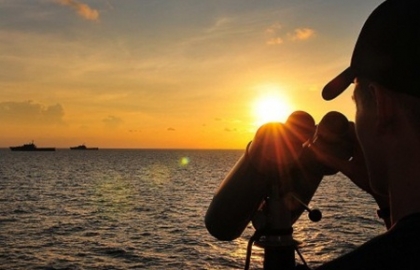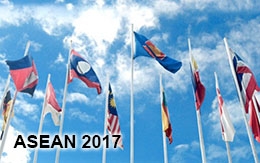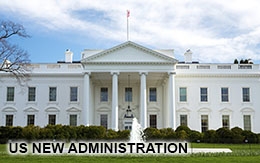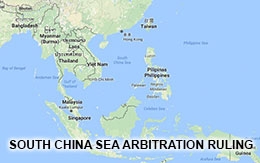The South China Sea: Have the Positive Trends in 2020 Continued in 2021?
South China Sea is the subject of interests far beyond the littoral states, for what happens in the South China Sea would have deep consequences elsewhere. Most states also clearly indicate preference to lawfare to other means of contestation, because a rules-based Indo-Pacific is in the interests of all.

2020 was a tough year, claimed Washington Post, Foreign Affairs, Council of Foreign Relations and many other headlining institutions while examining the COVID-19 pandemic, civil unrest, economic downturn and election instability in various countries. The South China Sea was no exception. This past year alone, the South China Sea witnessed rising competition among major powers, continuing militarization on the ground while COVID-19 was spreading, persistent frictions among the claimants which resulted in several standoffs, and the growing use of unconventional warfare, such as media propaganda and “gray zone” tactics. However, from Vietnam’s standpoint, 2020 also held some positive developments that might continue well into 2021.
Positive Trends in 2020
First, even with COVID-19, all parties in the South China Sea dispute were inclined to peaceful conflict settlement mechanisms, notably through the use of legal means. In this regard, China, Indonesia, the Philippines and Vietnam continued to demonstrate or clarify their maritime claims via a series of notes verbales submitted to the United Nations throughout the years. Moreover, non-claimants also sent their own submission for the first time, starting with the U.S. on June 6. Australia followed suit with its July 23 document. The ‘Big Three’ in Europe, namely Germany, France and the U.K. jointly expressed their positions through their respective notes. From December 2019 to July 2020 alone, a total of 15 notes verbales, two diplomatic letters and one statement were exchanged.
Apart from the notes verbales, the ASEAN-China negotiation process on the Code of Conduct (COC), after being disrupted by the pandemic, briefly resumed at the call of both sides. China’s Foreign Minister urged the resumption multiple times throughout the year. The Philippines publicly pushed for an “inclusive” COC on November 26, after President Duterte joined ASEAN leaders in showing willingness for an early conclusion of the process. Brunei, not traditionally being very vocal on the topic, nevertheless made its rare South China Sea statement in July which also underlines commitment to peaceful settlement of disputes in accordance with the 1982 UNCLOS.
The 2016 Arbitral tribunal ruling was increasingly recognized as an integral part of international law. The notes verbales from the Philippines, Indonesia, Australia and the European countries all referred to the ruling as a source to reject China’s historic rights. Philippine president Duterte brought this notion, for the first time, to the UN highest body in his UN General Assembly speech on September 23, saying the ruling is “beyond compromise and beyond the reach of passing governments to dilute, diminish or abandon.”
Second, the South China Sea received broader international attention as a key part of the increasing popular Indo-Pacific concept. As mentioned above, Australia, the U.S. and Europe’s ‘Big Three’ used their U.N. submissions to reject China’s ‘historic rights’ and claims to continental state’s outlying archipelagos. Australia, India and the U.S. also showed interests in the COC, saying the code should not be exclusive or harmful to other parties’ interests. Notable, the U.S. aligned their position in the South China Sea closer to the 2016 Arbitral rulings in the then-State Secretary Pompeo’s July statement, saying it is illegal for China to conduct economic activities in areas belonging to other claimants for the first time.
These countries also showed commitment to freedom of navigation. In 2020, the U.S. conducted 10 FONOPs in the South China Sea, even more than 2019 despite the challenges posed by COVID-19. France, Germany and the U.K. individually expressed their Indo-Pacific interests while indicating stronger military deployment in the South China Sea in the coming years. The EU representative at the 12th South China Sea Conference, explicitly articulated EU interests in the South China Sea, urged for a “fair, balanced and equitable” COC, and said its members’ navies would be “increasing present” there.
Thirdly, ASEAN was able to prove its continued relevance as a promoter of norms and maritime cooperation in the region. Under the chairmanship of Vietnam, ASEAN released multiple statements mentioning the South China Sea in a more unitary spirit than it did in the past, such as the ministerial joint statement in September or the Chairman statement in November. These documents all stressed the importance of UNCLOS as the legal framework for all maritime activities and the need for a COC in full compliance with international law and UNCLOS.
Amid the pandemic, ASEAN still pulled through with its diplomatic engagement. Besides the regular meeting schedule, ASEAN held its first Ministerial Meeting with the United Nations on October 21. On November 3, ASEAN held a workshop on promoting the just and humane treatment of fishermen in the South China Sea with China for the first time in 10 years. New initiatives were also put forward by ASEAN, such as the ASEAN Network for Combating IUU Fishing or the EAS’s Statement on Marine Sustainability.
External players emphasized the role of ASEAN while talking about the Indo-Pacific and the South China Sea. During the ASEAN-U.S. Ministerial Meeting on September 10, the U.S. secretary emphasized support for a united ASEAN that could consistently pursue peace, stability and freedom of navigation and overflight in the South China Sea. Australia said ASEAN is the core of the Indo-Pacific. The Quadrilateral Security Dialogue, despite not mentioning the South China Sea directly, also expressed strong support for ASEAN centrality in a region where all countries are sovereign, independent and resilient.
Developments in 2021
The first part of 2021 has passed and there are still many uncertainties ahead in the South China Sea. This year marks the 100th anniversary of China’s Communist Party, a phycological benchmark year for China which could boost nationalism and hence China’s assertiveness in the South China Sea. It is also the year of presidential transition in the U.S. The Trump administration fortified its footprint in the South China Sea in particular and Indo-Pacific in general, with last-minute moves such as the announcement of the integrated tri-service maritime strategies (for its Navy, Coast Guards and Marines), the declassified Indo-Pacific security strategy document, three more FONOPs in the last two months of 2020, and another South China Sea statement last January. Under Biden’s presidency, the U.S. seems to uphold the Trump administration’s position in the South China Sea but spoken of tactical adjustments, which remains to be seen. How high a priority is the South China Sea in Biden’s agenda is also an open-ended question.
With the ASEAN under the chairmanship of Brunei, a traditionally less vocal claimant than Vietnam, and the emerging shadow of the Myanmar issue, will the South China Sea be sidelined? Other middle powers have signaled stronger interests in the South China Sea. European countries like the U.K. and France have the potential to deploy military presence in the South China Sea this year, but will such presence be a frequent practice that contributes to overall stability? Can the Quad, now upgraded to leaders’ level, be able to transform its dialogues into something more operational or will it stick to its political symbol function and more unconventional security issues? How will the Philippines, with its lack of cohesion domestically regarding the South China Sea approach, act as its election is coming in a year? We also have to bear in mind that COVID-19 is still a dominant security concern, with the new variants and travels in the region still largely restricted.
However, early developments in 2021 so far seem to suggest that the first two positive trends observed last year would continue.
Legal tools still seem to be a preference as Japan submitted its note verbale on the South China Sea on January 19 and became the 10th country to do so. The document rejected China’s archipelagic baseline drawing and emphasized the value of the 2016 tribunal ruling. China then responded in kind with another note on January 28. Additionally, China passed its new Coast Guard which allows firing at foreign vessels on January 22 which drew strong reactions from the international community. Vietnam urged all parties to follow international law, seeing China’s new Coast Guard law as incompatible with parts of UNCLOS; Japan, the U.K. and the U.S. showed great concerns; and the Quad’s first ministerial meeting under Biden presidency in February saw China’s new law as a challenge.
The international community continues to show interest in the South China Sea. The U.S., under the new Administration, quickly showed its consistent South China Sea position, promising to protect the Philippines and maintain this area as a free and open sea. The U.S. also conducted two FONOPs in the area in February - very early into Biden’s presidency. To put it in perspective, the first FONOP under Trump was carried out around four months after the former President’s inauguration. With the most recent two FONOPs, the U.S. also acted more actively in term of controlling the narrative by releasing immediate FONOP statement rejecting any comments China made about the operations (China has started saying it “expelled” US ships out of its waters since 2017). The U.S. also held a record 41 exercises in the first 6 months, more than 60% the number of the same time last year. These data indicate the new administration’s commitment in this area.
Similar conclusion cans be said for the European powers. This February, French defense minister Florence Parly announced that two navy ships, including a nuclear attack submarine, had conducted a South China Sea patrol without prior notice. Shortly after, French frigate Prairial held a joint replenishing drill with the U.S. and Japan in regional water. Then, France announced its assault ship Tonnerre and frigate Surcouf would pass through the South China Sea during France’s annual Jeanne d’Arc mission. The U.K. deployed its latest air carrier, HMS Queen Elizabeth, to the South China Sea within the first quarter of 2021, when it announced its “Indo-Pacific tilt” in the integrated defense and foreign policy review in March. Germany also announced that it would sail its frigate through the South China Sea during its voyage to Asia in August 2021. That shall be the first time a German navy was present in the area since 2002.
European countries have also been vocal about the Whitsun Reef incidents, with the EU releasing an unexpected statement criticizing China’s actions in Whitsun Reef (considering its frequent neutral position in the past). In numerous high-level statements with Japan and the U.S. and within G7, the EU also expressed concerns about unilateral actions in the South China Sea. The same can be said about Japan as this country repeatedly call out coercive and escalatory actions in the South China Sea at multiple forums, such as Quad, G7, Japan-UK 2+2 or Japan-US summit, etc.
The third trend of ASEAN being able to prove its relevance is less certain. ASEAN is not broadly expected to be pushing for the South China Sea issue despite being under Brunei chairmanship, also a claimant. Brunei is seen as a much less vocal claimant than the others. The ASEAN has also made online efforts to resume the COC negotiation with China after more than a year delay due to COVID-19. However, progress is yet to be seen.
On another hand, the situation in Myanmar is poised to divert ASEAN’s attention from the South China Sea and affect ASEAN’s overall consensus now that a member state is not properly functioning in the organization. If there is no rightfully recognized representative for Myanmar, or if the Myanmar issue occupies too much attention, the South China Sea agenda might not receive full ASEAN attention. Another possibility is, if the military side in Myanmar inclines towards China, ASEAN will not achieve any breakthrough in the South China Sea.
It is also worth noting that, with the Quad’s profile rising (with many activities, including an online Summit in March and another in-person Summit in the work, ASEAN risks become pale in comparison even though all Quad members and the European countries support ASEAN centrality.
Conclusion
The South China Sea is becoming less known as a contest over maritime features and resources, and better known as a contest over the heart of a geopolitically important Indo-Pacific, as well as contests over the rules that govern state interactions, both at sea and generally. Seen this way, the South China Sea is the subject of interests far beyond the littoral states, for what happens in the South China Sea would have deep consequences elsewhere. Most states also clearly indicate preference to lawfare to other means of contestation, because a rules-based Indo-Pacific is in the interests of all. Let us hope that the South China Sea debate would continue through the clarification of one’s understanding on how the laws, particularly the 1982 UNCLOS, should be interpreted and applied in this body of water, for that would be the way to narrow the gaps of understanding and achieve a lasting rules-based order for the region.
Dr. Nguyen Hung Son is Vice President of the Diplomatic Academy of Viet Nam. Do Hoang is a researcher at the Diplomatic Academy of Vietnam. The piece reflects the author's own views, not the institutions they are affiliated with.









